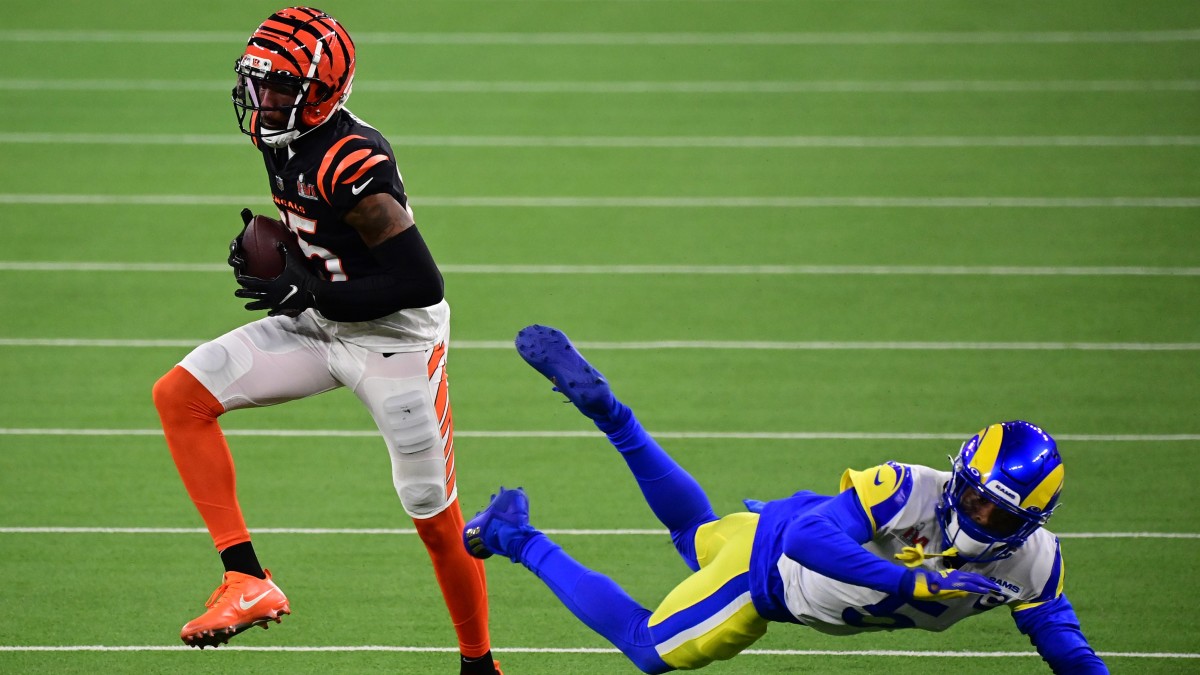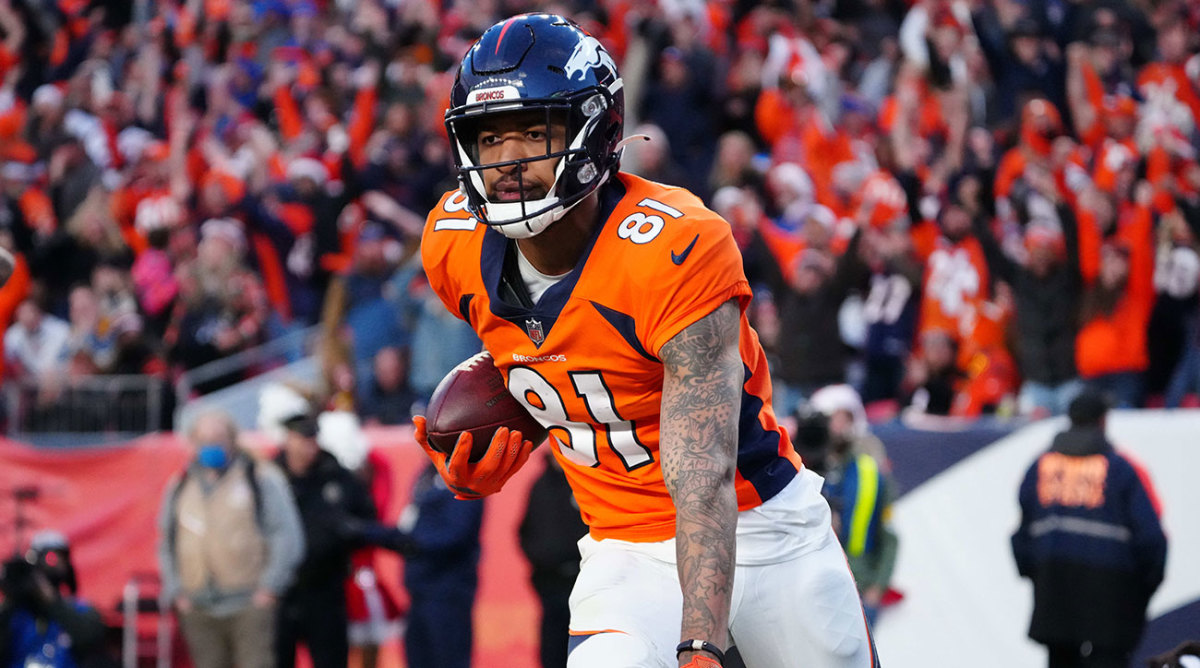Every AFC Team’s Most Underrated Player in 2022

What makes a player underrated? If you ask players, they’re likely to say it’s a media-driven conversation; that we are the ones who control nebulous topics with weighty words like “best” and “worst.” If you ask GMs, one would imagine it’s a financial conversation. Who are they getting the most out of, versus how much they are shelling out for the privilege? If you ask fans, they’re likely to say a person they appreciate on a weekly basis but do not hear much about from sports outlets that don’t exclusively cater to their local market.
It is with all of that in mind that we compile our annual list of players who are underrated. They can be a combination of any and all of these things. Who isn’t getting the credit they deserve? Who is doing some unsexy job that deserves to get noticed? Who do we think is great, who may be routinely picked on by local and national media?
The floor is ours, and, invariably, yours once this goes live. Don’t be a stranger. Let us know who we missed, and who should be in consideration for future lists.
Buffalo Bills
Isaiah McKenzie, wide receiver
There’s a good chance I’m overrating a few specific performances, so call me out on my biases as you will. That said, watching McKenzie last year, especially when he was filling in for Cole Beasley late in the season, was like watching a vintage Percy Harvin or, at times, an Antonio Brown–ish kind of performance out of a 5'8" player who was a special teams factor as well as a jet sweep threat out of the backfield. There was so much to like about his game, despite McKenzie being buried on the depth chart. If the going rate from an owner to a coach is $100,000 per loss, McKenzie, who is going to make a little more than $100,000 per game this year, is quite a bargain, especially when he can be the difference-maker in a tight game against the Patriots.
Miami Dolphins
Andrew Van Ginkel, linebacker
I thought about listing safety Jevon Holland here, but I feel like being named to the PFWA All-Rookie team kind of blows your cover. Plus, Van Ginkel is interesting to me as a linebacker. He struggles in coverage, and was picked on quite a bit last year. He surrendered a completion percentage near 80% and an opposing quarterback rating of more than 100 when targeted. That said, I picture him against the Ravens adequately setting the edge against 500 pounds of humanity guarding Lamar Jackson and somehow containing the whole thing. As the league delves further into wide-zone rushing and its intricacies, players like Van Ginkel are going to be so valuable, even if they are also a bit vulnerable.
New York Jets
Alijah Vera-Tucker, guard
While AVT was a first-round pick, we don’t often think of him as one of the NFL’s elite offensive linemen. At least not yet, which qualifies him (in my mind) for a post about underrated players. The end of his 2021 season solidified as much in my mind. I’m not going to pretend to take credit for this. Here’s an excellent cut up of his performance against the Buccaneers which completely blew me away. I was consistent in saying that the hiring of John Benton as run game coordinator and offensive line coach was one of the Jets’ biggest hires since Bill Callahan. This highlights all the ways in which Benton can mold a prospect for the outside-zone system. I also rewatched some of Vera-Tucker against the Saints to see how he fared against a truly elite front and came away impressed. There’s no doubt he has the mass, the toughness and the athleticism. What’s missing now is simply the quantifiable team success.
New England Patriots
Michael Onwenu, guard
What a luxury it was for New England to trot him out as a sixth offensive lineman (after starting him through the first nine weeks of the season last year). Onwenu is versatile, athletic and has fists made of cinderblock. Against the Jets earlier last year while Onwenu was an everyday starter, he was standing up defensive linemen like an oversized nightclub bouncer. Onwenu was raw enough to earn himself a trip to the Bill Belichick Hard Lessons Learned Academy, but that doesn’t change the fact that he’s young, incredibly cheap (as a 2020 sixth-round pick) and knows how to play at least three positions well already.

Cincinnati Bengals
Tee Higgins, wide receiver
It was fun to look back on the beginning of the Bengals’ season to see how defenses played Ja’Marr Chase before they knew he was Ja’Marr Chase. His first career catch against the Vikings and his first touchdown of the season, also against the Vikings, showed how much respect Higgins earned from the defense. Cincinnati was able to work certain high-low concepts and vertical concepts that forced good defenders to choose between Higgins and Chase. The fact that it was a tough decision is a complement to the Clemson wideout and former second-round pick. Chase’s arrival onto the scene was incredible, but that foundation was laid years ago, with some solid drafting to piece together a worthwhile core around him. Though Chase had one of the best completion percentages above expectation last year, Higgins wasn’t too shabby either, hauling in 1.1% above what was reasonably expected of him. All of this makes Joe Burrow better.
Cleveland Browns
Jadeveon Clowney, defensive end
Signing Clowney was incredibly necessary for the Browns if they plan on reaching the postseason and realizing their superteam aspirations. Only three Browns defensive players accumulated more net yards over average, according to NFL GSIS statistics. Meaning, when Clowney was on the field, he saved the Browns roughly 380 yards versus an average replacement player. The only ones better on Cleveland’s defense? Myles Garrett, Malik McDowell and Denzel Ward. Clowney has become something of a mercenary at the end of his career, but at age 29 is playing better football than his three consecutive Pro Bowl years on the Texans. He has been around the NFL long enough to ably handle any kind of quarterback, which makes him equally valuable as a patient chess player against someone like Lamar Jackson or as a pure bull off the edge against Joe Burrow.
Baltimore Ravens
Mark Andrews, tight end
Last year, we performed a love power ballad for Patrick Ricard, the team’s 300-pound defensive lineman and fullback. This year, we’ll highlight Mark Andrews. Of course, you know Mark Andrews. You probably had him on your fantasy team last year after you missed out on a chance to draft George Kittle or Travis Kelce. Andrews often comes in behind those two tight ends, despite being arguably the best overall blocker as well as the most dependable wide receiver. While Kelce and Kittle had a slightly better completion percentage above expectation last year, Andrews was playing with both Lamar Jackson and Tyler Huntley. Jackson’s slew of nontraditional releases often “get” the ball there, but not always identically and formulaically. I don’t think it’s controversial to argue that it’s both more rewarding and more difficult to be a tight end in the Ravens’ system for several reasons, including the increased focus on physical run blocking and the increased number of improvisational plays. Andrews’s inclusion on this list may raise some eyebrows from people who think he’s too good to be here. But the point we are making is that he is even better than you already think he is.
Pittsburgh Steelers
Pat Freiermuth, tight end
The headline of this catch is that Ben Roethlisberger fit a throw into a tight window. The actual reality of this throw is that Freiermuth was playing pickup basketball against a category of athlete not in his universe. He patiently waits out the throw knowing the ball is coming to him, adjusts his speed and somehow picks the ball between two converging defenders (who happen to play for one of the best defenses in football). He bodies his way into the end zone with no difficulty. This is a rookie playing in a divisional game against the future conference champions. Freiermuth was graded well as a blocker by Pro Football Focus, and I went back to see how he fared against the Browns. The Steelers were starting a rookie left tackle and presumably needed to lean on Freiermuth to help with Myles Garrett. And while there was certainly some contact (he did what I think we all would do in that situation, diving at Garrett’s legs), I came away with a further appreciation for his ability to get open. Freiermuth has a sharp cut and on plays where Roethlisberger was clearly in danger, he was the “hot” emergency read, meaning that they trusted him to be in the right place at the right time.
Indianapolis Colts
Grover Stewart, defensive tackle
What’s cool about Stewart, the former Albany Great Dane, is that he’s become a good enough defensive player that he can’t be left single blocked, given how heavy-handed he’s become and how destructive he can be simply romping his way into the backfield. For the Colts’ stunt-heavy defense under former coordinator Matt Eberflus, this was a dream come true. For DeForest Buckner, it’s probably the best pairing he’s had on a defensive line since his Super Bowl run with the 49ers. Stewart played on almost 60% of the Colts’ snaps and was not a run-exclusive player, affecting the passing game with his long limbs and comfort moving around a mass of bodies trying to get hands on him. Stewart saved the Colts almost 70 total rushing yards by his presence on the field last year, according to NFL GSIS data. Teams running the ball against Indianapolis without Stewart gained almost 0.2 yards extra per carry. Over the course of a long season, that matters.
Jacksonville Jaguars
Dawuane Smoot, defensive end
Smoot had six sacks last year in his age-27 season, giving him 17 over the past three seasons on a defensive line that wasn’t doing him many favors. Smoot had a career high in tackles for loss last year and impressed as a run defender, especially in Jacksonville’s first game against the Titans. Still featuring peak Derrick Henry, the Titans ran right at Smoot, and he held his own amid the outside-zone wave, often kicking Henry back inside to a slew of willing tacklers. Smoot also has a nice bend off the edge, and may have had 2.5 sacks in that Titans game had an offensive lineman not grabbed him by the neck when he got near Ryan Tannehill.
Houston Texans
Jonathan Greenard, linebacker
Greenard had back-to-back multi-sack games last year for the Texans, playing on a little more than half Houston’s total snaps. With improvements on their defensive line, he seems to have the speed and instincts to become an elite speed rusher (again, if there is some help to muddy up the offensive line and the backfield). On his own, Greenard has some surprisingly lively hands, and shocked Indianapolis’s right tackle on the opening drive last year, dropping him to the ground while Greenard flew around the edge to sack Carson Wentz. Houston has not been in many situations to close out games, but it feels like the better the Texans get, the more we’ll notice him as a player who compiles sacks and pressures (i.e., not a ton of teams were throwing the ball late in games against the Texans last year).
Tennessee Titans
Amani Hooker, safety
Imagine being such a good open-field tackler that someone goes through the trouble of making a 13 second YouTube clip of you preventing a first down in a regular-season game. That’s Hooker. He’s the one making a ridiculous directional adjustment to cut off Josh Allen at the end of a potential game-winning drive and force the Bills into a fourth down. While most of his usage came after Week 10, Hooker left his mark on the season, allowing a 68.6% completion rate and an opposing quarterback rating under 90. While some of his success is credited to a beautifully designed defense and the cerebral play of star safety Kevin Byard, Hooker could help turn the Titans into a safety-driven defense like we’ve seen succeed in Buffalo.

Denver Broncos
Tim Patrick, wide receiver
Patrick added an extra 4.1 yards per reception last year, which was in the same vicinity of Terry McLaurin, Hunter Renfrow, DK Metcalf and Jaylen Waddle. While his weapon of choice is decidedly less sexy, bulling ahead and simply out strengthening his opponents works just the same. Patrick has already developed a rapport with new quarterback Russell Wilson and, despite being stylistically different from Wilson’s two loyal targets in Seattle, Patrick could finally be appreciated for the wideout he’s capable of being in a maximized offense. As of now, he’s put together a solid run in Denver with Case Keenum, Joe Flacco, Brock Osweiler, Trevor Siemien, Jeff Driskell, Teddy Bridgewater, Drew Lock … and so on.
Los Angeles Chargers
Matt Feiler, guard
Only Mike Williams netted the Chargers more yardage versus an average replacement player than Matt Feiler last year. That’s right. Feiler was worth roughly an additional 0.69 yards per play in 2021 while Justin Herbert was only worth an additional 0.64. Let’s put the former Lampeter-Strasburg (Go Pioneers) and Bloomsburg (Go Huskies) product behind center and see what he can do, right? We didn’t put Feiler on this list because he attended two of my favorite football powerhouses before reaching the NFL, we put him on the list because of games like last year’s matchup against the Chiefs. With the unproven Trey Pipkins next to him on a crucial third down, Feiler got the business end of an all-out blitz, having to block as many as three people at once, keeping a host of Chiefs out of Herbert’s lap. Two plays later he threw an epic shoulder check on Derick Nnadi on a Herbert touchdown scramble. It seemed that on almost every play, Feiler was doing something clinical, making a little difference on the success of a given play.
Kansas City Chiefs
Trey Smith, guard
A cool moment I stumbled across: Chiefs-Bengals, final week of the season, a third-and-2. Smith, who was a rookie sixth-round pick was heads-up on the very talented Larry Ogunjobi. Ogunjobi drifted to Smith’s right, engaging the right tackle, leaving Smith without someone to block in a critical short-yardage situation. So, after barely turning his head, he shoulder-checked DJ Reader to the ground, freeing up center Creed Humphrey. While Smith had the benefit of playing with some incredible players last year, you don’t become a great offensive lineman with Patrick Mahomes as your quarterback by accident. Mahomes takes longer than almost any elite quarterback in football to throw, and we saw bad lineman get exposed at the hands of able blitzers in Kansas City’s Super Bowl LV loss to the Buccaneers. Teams will find you and expose you if you can’t hang. Smith, who played more than any guard in football last year, can most certainly hang. And, he costs next to nothing (for now).
Las Vegas Raiders
Nate Hobbs, cornerback
The strange thing about the Mike Mayock and Jon Gruden era was that they found some superstar players in the middle rounds, despite largely struggling with their early-round draft capital. Hobbs, who was a fifth-round pick out of Illinois and played 76% of the team’s snaps in his first season, finished the season with just one interception and an 82% opposing quarterback completion percentage. While those numbers don’t look great, his willingness in run situations, and to recover on short passes where he may have been legally picked out of the play, exploded off the screen. Hobbs is the ideal modern cornerback with long limbs and a pronounced fearlessness when the ball is in the air. Hobbs is instinctive, scrappy and already has a good feel for how to manipulate a quarterback.
More NFL Coverage:
